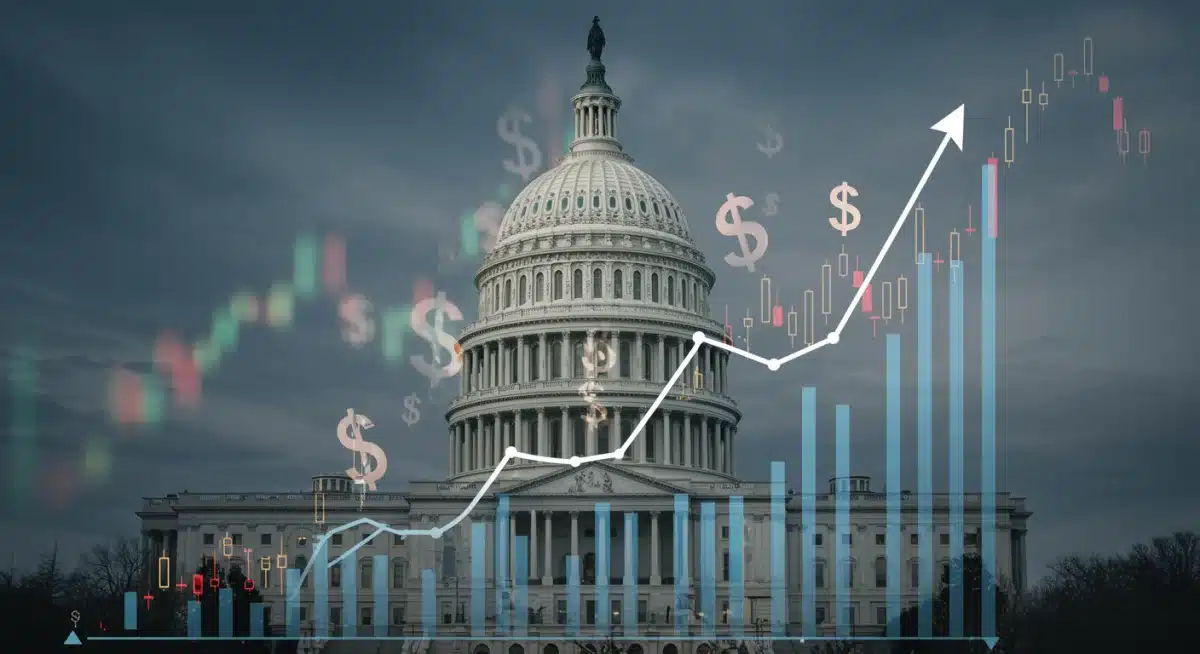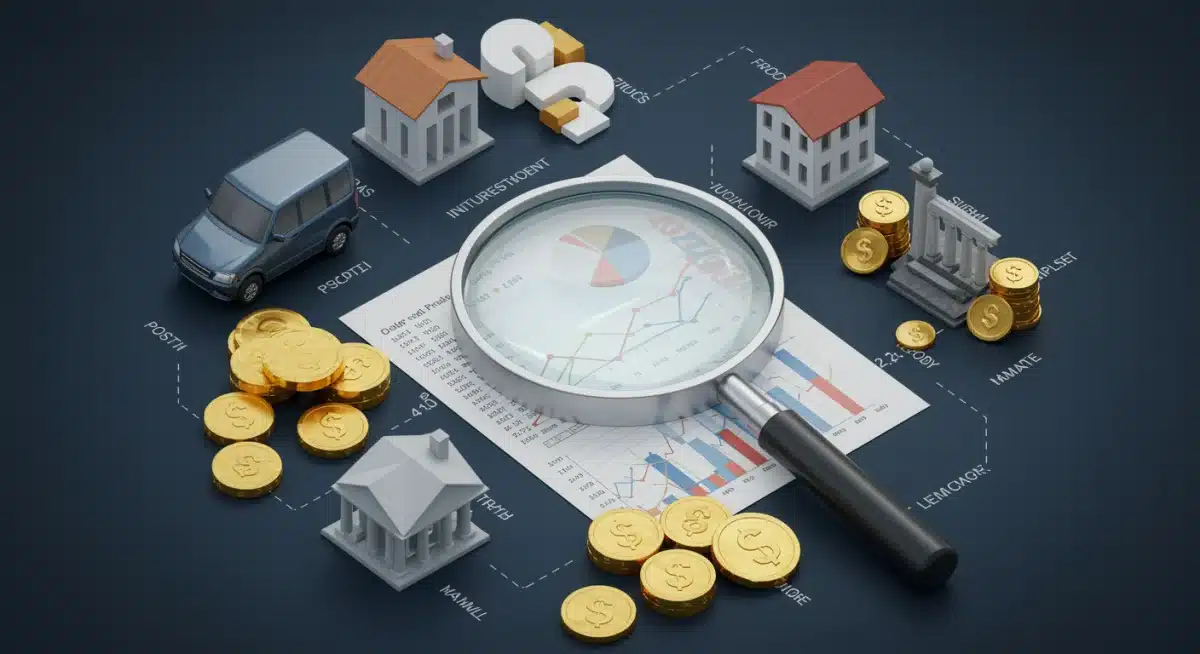2025 Fed Rate Hikes: Investor’s Guide to Portfolio Protection

Understanding and preparing for the 2025 Federal Reserve interest rate hikes is crucial for investors seeking to safeguard and grow their portfolios amidst anticipated economic shifts.
The financial landscape is ever-evolving, and as we approach 2025, the prospect of the 2025 Federal Reserve interest rate hikes looms large for investors. Understanding these potential shifts and their implications is not just prudent; it’s essential for safeguarding your financial future.
This guide will equip you with the knowledge to navigate these changes effectively.
Understanding the Federal Reserve’s Role and Rate Hikes
The Federal Reserve, often referred to as the Fed, is the central banking system of the United States. Its primary mandate is to maintain maximum employment, stable prices, and moderate long-term interest rates. To achieve these goals, the Fed utilizes various monetary policy tools, with adjusting the federal funds rate being one of the most prominent.
When the Fed raises interest rates, it’s typically a response to inflationary pressures or a sign of a strengthening economy. These rate hikes influence everything from consumer lending rates to corporate borrowing costs, ultimately impacting investment portfolios.
Why the Fed Raises Rates
Interest rate hikes are not arbitrary decisions; they are carefully considered moves by the Federal Open Market Committee (FOMC) based on a thorough analysis of economic indicators. The primary reasons often revolve around curbing inflation and preventing the economy from overheating.
- Controlling Inflation: When inflation rises above the Fed’s target, increasing interest rates makes borrowing more expensive, which can slow down economic activity and reduce demand, thus easing inflationary pressures.
- Economic Stability: Rate hikes can also be a proactive measure to prevent asset bubbles and ensure sustainable economic growth by cooling down an overly enthusiastic market.
- Normalizing Policy: After periods of low interest rates to stimulate the economy, the Fed might raise rates to return to a more “normal” monetary policy stance, creating room to cut rates again if a future downturn occurs.
The impact of these decisions ripples through various sectors. Higher borrowing costs for businesses can affect their expansion plans and profitability, while consumers might face higher mortgage rates and credit card interest. For investors, this translates into a need for strategic adjustments to their portfolios. Anticipating these moves and understanding their underlying rationale is the first step in effective portfolio protection.
Impact on Different Asset Classes
Federal Reserve interest rate hikes do not affect all asset classes equally. Understanding how different investments react to rising rates is critical for making informed decisions and protecting your portfolio. Some assets may thrive, while others could face headwinds.
Bonds and Fixed Income
Generally, bond prices move inversely to interest rates. When interest rates rise, newly issued bonds offer higher yields, making existing bonds with lower yields less attractive. This causes the market value of existing bonds to fall.
- Short-Term vs. Long-Term Bonds: Short-term bonds tend to be less sensitive to interest rate changes than long-term bonds. This is because their shorter duration means investors can reinvest at higher rates sooner.
- Inflation-Protected Securities (TIPS): These bonds are designed to protect against inflation, making them potentially more appealing in an environment where the Fed is raising rates to combat rising prices.
- Floating-Rate Notes: The interest payments on these bonds adjust periodically, which can make them attractive during rising rate environments as their yields increase with market rates.
Investors holding a significant portion of their portfolio in fixed income should evaluate the duration of their bonds and consider strategies to mitigate potential losses, such as laddering bond maturities or shifting towards shorter-duration instruments. This proactive approach can help buffer the negative impact of rising rates on bond portfolios.
Equity Market Reactions to Rate Hikes
The equity market’s reaction to interest rate hikes is more nuanced and can vary significantly across different sectors and company types. While higher rates can increase borrowing costs for corporations and potentially dampen economic growth, certain sectors may be more resilient or even benefit.
Growth vs. Value Stocks
Growth stocks, often characterized by high valuations and future earnings potential, can be more vulnerable to rising interest rates. This is because higher rates reduce the present value of future earnings, making these stocks less appealing. Conversely, value stocks, which are typically mature companies with stable earnings and lower valuations, may perform relatively better.
Sectors like financials, particularly banks, often benefit from rising interest rates. They can charge more for loans, increasing their net interest margins. Conversely, sectors heavily reliant on borrowing for capital expenditures, such as utilities or technology companies with significant debt, might face increased costs and reduced profitability.
Investors should analyze their equity holdings for exposure to interest-rate-sensitive sectors and consider rebalancing towards more defensive or value-oriented stocks. Diversification across various industries and market capitalizations remains a cornerstone of robust portfolio management in such environments.
Real Estate and Alternative Investments
Interest rate hikes have a profound effect on the real estate market and can also influence the attractiveness of alternative investments. Understanding these dynamics is key to a well-rounded portfolio strategy.
Real Estate Implications
Rising interest rates typically lead to higher mortgage rates, which can cool down the housing market by making homeownership less affordable. This can result in reduced demand and slower appreciation, or even declines, in property values.
- Residential Real Estate: Higher mortgage rates can reduce buyer affordability, potentially slowing sales and price growth.
- Commercial Real Estate: Increased borrowing costs for developers and investors can impact new projects and property valuations.
- REITs (Real Estate Investment Trusts): While REITs can be sensitive to interest rates due to their debt leverage, those with strong balance sheets and properties in high-demand sectors may still perform well.
For investors in real estate, it might be a time to be more selective, focusing on properties with strong rental income potential or those in resilient markets. Evaluating the debt levels of any real estate investments is also crucial.

Alternative Investments
Alternative investments like commodities, hedge funds, and private equity can offer diversification benefits during periods of rising interest rates. Commodities, for instance, often act as an inflation hedge, as their prices tend to rise with general price levels.
Hedge funds and private equity, with their less correlated returns to traditional markets, can provide stability. However, their performance can also be influenced by the broader economic environment shaped by interest rates. Investors should assess how these alternatives fit into their overall risk profile and diversification goals, especially when traditional assets face challenges.
Strategies for Portfolio Protection in 2025
As the prospect of the 2025 Federal Reserve interest rate hikes approaches, adopting proactive strategies for portfolio protection becomes paramount. A well-thought-out plan can help mitigate risks and potentially uncover new opportunities.
Diversification and Asset Allocation
Diversification remains a cornerstone of prudent investing. Spreading investments across various asset classes, sectors, and geographies can help cushion the blow if one particular area underperforms. Rebalancing your portfolio to align with your risk tolerance and investment goals in a rising rate environment is crucial.
- Review Your Asset Mix: Ensure your portfolio’s current asset allocation aligns with your long-term objectives and risk appetite, adjusting as needed to reflect the changing economic landscape.
- Consider Inflation Hedges: Assets like commodities, Treasury Inflation-Protected Securities (TIPS), and real estate can offer protection against inflation, which often accompanies rising rates.
- Geographic Diversification: Investing in international markets can provide exposure to economies that may be at different stages of their economic cycle or have different monetary policies.
Strategic asset allocation means not just diversifying, but also actively managing your portfolio based on market conditions. This might involve reducing exposure to highly interest-rate-sensitive assets and increasing allocations to those that historically perform better during rate hike cycles. Regular review and adjustment are key to maintaining a robust portfolio.
Short-Term vs. Long-Term Investment Horizon
The impact of Federal Reserve interest rate hikes can differ significantly depending on an investor’s time horizon. Short-term investors might need to be more reactive, while long-term investors can often weather temporary market fluctuations.
Adjusting for Short-Term Volatility
For those with a short-term investment horizon, managing liquidity and minimizing exposure to volatile assets become critical. Cash and short-term fixed income instruments can offer stability, albeit with potentially lower returns.
Tactical adjustments, such as reducing leverage or taking profits from highly appreciated assets, might be considered to preserve capital. However, attempting to time the market perfectly is notoriously difficult and often leads to missed opportunities.
Long-Term Resilience
Long-term investors, on the other hand, often have the luxury of riding out market downturns. The compounding effect of returns over many years can significantly outweigh short-term volatility. Maintaining a diversified portfolio and sticking to a well-defined investment plan are usually the best approaches.
Focusing on high-quality companies with strong fundamentals, durable competitive advantages, and consistent cash flows can be beneficial. These companies are often more resilient to economic headwinds and can continue to generate returns over the long haul, even in a rising rate environment. The key is to avoid making rash decisions based on short-term market noise and to maintain a disciplined approach consistent with long-term financial goals.
The Role of Financial Advisors and Continuous Monitoring
Navigating the complexities of the 2025 Federal Reserve interest rate hikes requires more than just a passing understanding of economic principles. The guidance of experienced financial professionals and a commitment to continuous monitoring of market conditions are invaluable.
Leveraging Expert Advice
A qualified financial advisor can provide personalized insights tailored to your specific financial situation, risk tolerance, and investment goals. They can help you understand the potential implications of rate hikes on your portfolio and craft a strategy that aligns with your objectives.
- Personalized Strategy: Advisors can help create a customized investment plan that considers your unique circumstances and future aspirations.
- Risk Assessment: They can assess your portfolio’s sensitivity to interest rate changes and recommend adjustments to mitigate potential risks.
- Emotional Discipline: During periods of market uncertainty, an advisor can help you avoid emotional decision-making and stick to your long-term plan.
The expertise of a financial advisor extends beyond just investment selection; they can also assist with tax planning, estate planning, and retirement strategies, all of which can be impacted by changes in the economic environment.
Continuous Market Monitoring
The financial markets are constantly evolving, and what holds true today might change tomorrow. Staying informed about economic indicators, Federal Reserve communications, and global events is crucial for making timely adjustments to your portfolio.
Regularly reviewing your portfolio’s performance, rebalancing as necessary, and being prepared to adapt your strategy are essential components of successful investing. While it’s important to be aware of market trends, avoid making knee-jerk reactions. Instead, focus on a disciplined, long-term approach supported by expert advice and consistent monitoring.
| Key Point | Brief Description |
|---|---|
| Fed’s Role | The Federal Reserve adjusts interest rates to manage inflation and stabilize the economy. |
| Asset Impact | Rising rates typically hurt bonds, can affect growth stocks, but may benefit financials and commodities. |
| Protection Strategies | Diversification, rebalancing, and considering inflation hedges are key for portfolio protection. |
| Advisor Guidance | Seeking expert financial advice and continuous monitoring are crucial for informed decisions. |
Frequently Asked Questions About 2025 Fed Rate Hikes
The Federal Reserve primarily raises interest rates to combat inflation when it exceeds their target. This typically occurs during periods of strong economic growth and high demand. By making borrowing more expensive, the Fed aims to slow down economic activity, reduce demand for goods and services, and ultimately bring price increases under control.
Rising interest rates can have a mixed impact on the stock market. Higher borrowing costs for companies can reduce profitability, especially for growth stocks that rely on future earnings. However, certain sectors like financials may benefit. Overall, increased rates can lead to market volatility and a shift towards value-oriented investments as investors seek more stable returns.
To protect your bond portfolio during rate hikes, consider strategies like investing in short-term bonds, which are less sensitive to interest rate changes. Laddering maturities can also help, allowing you to reinvest at higher rates as older bonds mature. Inflation-Protected Securities (TIPS) and floating-rate notes are also options as their yields adjust with market rates.
Yes, adjusting real estate investments in anticipation of rate increases is prudent. Higher interest rates typically lead to higher mortgage rates, which can cool the housing market. Focus on properties with strong rental income potential or those in resilient markets. For REITs, evaluate their debt levels and exposure to rate-sensitive sectors to make informed decisions.
Diversification is extremely important when facing potential Fed rate hikes. By spreading investments across various asset classes, sectors, and geographies, you can mitigate risks. Different assets react differently to rising rates, so a diversified portfolio helps cushion the impact of underperforming sectors and enhances overall portfolio resilience against market fluctuations.
Conclusion
The anticipated 2025 Federal Reserve interest rate hikes present both challenges and opportunities for investors. By understanding the Fed’s motivations, the varied impacts on different asset classes, and implementing strategic portfolio adjustments, investors can navigate this period with greater confidence. Proactive planning, informed decision-making, and leveraging expert advice are crucial for safeguarding and potentially growing your wealth in an evolving economic landscape. Staying vigilant and adaptable will be key to long-term financial success.





